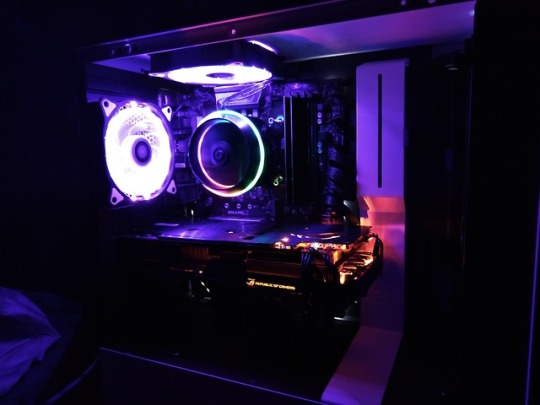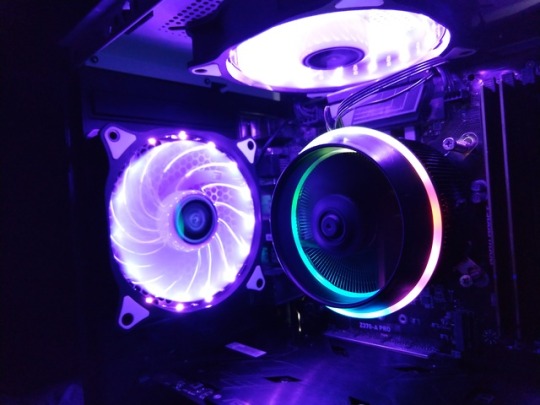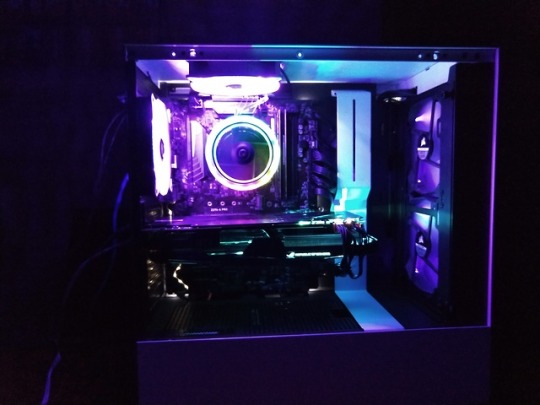#and even SSDs are starting to be viable for mass storage
Explore tagged Tumblr posts
Text
This is one of the reasons why I try to buy as much physical media as possible. I always buy a band's CD whenever I go to a concert, and if I have an album I really like, I always buy the physical CD. Same with movies - if I really like a movie (as in I will watch it > 5 times), I almost always buy it on Blu-ray / UHD Blu-ray.
It also helps that I have a Blu-ray drive in my current desktop and use it to make backups of my movies and CDs. And in case anyone is asking about copyright - in most cases, there is an archival copy / backup copy exception, which means you can rip CDs, DVDs, Blu-rays, etc. as long as you keep in on your PC and don't distribute it. Playing it over a NAS / home network / Plex server is where you start getting into the gray area, since it technically leaves your PC.
And as for my PC, I recently made the switch to Linux, which is 100% free and open-source. Due to being on Linux, I also use open-source alternatives to most programs, like GIMP instead of Photoshop, LibreOffice instead of MS Office / Office 365, and Firefox instead of Chrome.
Another plus in open-source software is that you know EXACTLY what's in it because you have access to the source code, and if necessary, you can audit it. So no company is ever going to sneak in some telemetry or a hidden kill switch, etc.

#like every linux user i have to mention i use linux#i actually made the transition over to linux recently#and now i fully embraced it#one problem with keeping backups of physical media is hdd space#but now that 20 tb hdds exist it shouldn't be a problem#and even SSDs are starting to be viable for mass storage#although SSDs are still expensive compared to spinning HDDs
38K notes
·
View notes
Photo







Have I gone too far? Or have I gone NOT TOO FAR ENOUGH?
Some notes on rebulding my computer below.
Sorry the gifs are kinda meh.
So first of all, full confession, I bought that 2060 back in uh... *checks notes* March? I think I posted about this somewhere. And then it wouldn’t fit in my case, so I bought a new case, and then was real busy for a weekend or two and then... the entire project just... laid forgotten. Because I’m a lazy bitch like that sometimes.
So yeah for like six months I had a bright shiny new video card and case and didn’t use them.
Last weekend I got fed up with myself and moved it all to the new case. I showed some pictures to my coworkers and one was like “Ew, why do you still have that Intel stock fan on your processor?” Also I agreed, it looked like crap and was on sideways so, I decided to get a better processor fan. Also, the red fan on top was never my favorite, it came with my previous case, and was really harshing the vibe I was going for. So this week I spent like $40 more on a much better heatsink/fan for the processor and some other purple fans for the top and back.
I would highly NOT reccommend that particular heatsink / fan I got. It was, by far, the most frustrating part of this entire build and very high in the list of most frustrating components I’ve ever installed on any computer, ever, and I’ve been building my own computers since the late 90′s. It may be better on some motherboards, but the base that fits on the back of the motherboard doesn’t quite line up with the holes in the motherboard because there’s a slight bump on the processor backing. So TBH, the fan itself is only anchored on two sides and I’ll be keeping a close eye on if it starts wiggling free in a few months.
Also, turns out my motherboard is old enough where it doesn’t have the required plug for RGB control for a heatsink/fan with RGB, so I was hoping that I could get it to sync with the video card RGB. And it would, but since I can’t plug that control in, instead it’ll just be a fun rainbow spin all the time. It doesn’t match like I want it to. But that’s my own fault for not having a newer motherboard. I don’t see myself getting a new MB for another year or two so, for now, this is how it is.
The top fans are a bit brighter than I was hoping for honestly, I was kind of thinking they’d have the softer purple glow like the 2 purple Corsair fans in the front, but honestly, they work and I like them? I mean I like the color they give off when not looking at the fans themselves, they’re a bit bright when you look at them. My only real complaint about them is that they have a cord which can connect to a power supply with two different adapters and there’s not enough space between the two adapter types on the wire, so the much larger and uglier adapter was difficult to hidefor both, but after some finagling, you can barely see them, and not at all in those pictures.
I TRULY love this case and can’t imagine replacing it anytime soon. The glass front is easy to get off and put back on, the case back is well laid out (even if I didn’t manage the cables as well as I could have), there’s plenty of space and it even thoughtfully left space open to easily put the mount on the heatsink back so i didn’t have to take the entire motherboard out. (I would have returned the heatsink before doing that, tbh.)
I think I’m done tinkering with it for a year or two, though.
So, current specs in my Mid-Range gaming PC:
Motherboard: MSI Z370-A Pro Processor: Intel 8th Gen Core i5-8400 Processor Video Card: Strix GeForce RTX 2060 Case: NZXT H500 RAM: G.SKILL FORTIS Series 16GB (2 x 8GB) 288-Pin DDR4 SDRAM DDR4 2400 (Maybe my next upgrade.) Mouse: Logitech G600 MMO Gaming Mouse Keyboard: Microsoft Ergonomic keyboard (I really want a comfortable mechanical ergonomic keyboard RGB but haven’t found anything viable yet.) Sound: Logitech G533 Wireless Gaming Headset Monitors: 2x ASUS VE278H 27" Full HD 1920x1080 HDMI VGA Back-lit LED Monitor. Honestly, after memory, I want to upgrade to get a 4k gaming monitor here next. But they’re fine. Storage: 2TB hard drive, 3TB in SSDs
B: BoyThat’sALotOfStuff:WD Black 2TB Performance Desktop Hard Disk Drive - Slow but reliable storage for pictures, media, backups of stuff from old hard drives, general file / archive drive.
C: LocalDisk - Samsung 840 Series SSD 250 GB for Windows and misc. programs installed.
G: Games - Samsung 850 EVO 500TB SSD for video games... only about 50gb free on this one.
M: MassEffect - another 250gb Samsung 840 Series for all 4 Mass Effect games + Mods, also all three Dragon Ag games and The Sims 4 are on there too. I’d move The Sims off if it wasn’t such a hassle.
S: SoManyGames - Samsung 860 QVO 1TB SSD... Oh yeah uh, I bought this on sale like a year ago and FORGOT and found it while doing some housecleaning recently, and literally installed it yesterday. I think I’m gonna download and install a lot more games now.
V: Video Games - My other main 1TB SSD for Video Games.... only about 25% full. I think this is also Samsung, but not 100% sure.
3 notes
·
View notes
Text
USB Flash Drives: Components, Uses, and Myths Dispelled
The USB flash drive—also known as a jump drive, data stick, or thumb drive—continues to be the most popular portable storage device, with sales estimated to exceed 500 million annually by 2020. Although cloud storage is making headway in the same market spaces, USB drives offer capacity, speed, and size that make them ideal for many uses beyond just storage, including some perhaps unexpected uses as well. This article explores what’s inside a USB flash drive, explores various uses, and dispels common myths.
A Look Inside
A typical USB flash drive includes a USB connector, a mass storage controller, one or more flash memory chips, and a crystal oscillator, as well as additional features such as jumpers, LEDs, switches, and unpopulated space.
The memory capacity and speed of USB drives continue to increase. As of the time of this writing, 512GB USB drives are becoming common, with 1TB capacity also available. The average speed for a highly-ranked 64GB USB 3.0 device is 104MB/s for a write operation and 171MB/s for a read operation.
Recently, USB drives incorporated the Type-C connector, which provides a yet even smaller and thinner connector compared to the Type-A connector. The Type-C connector has a rounded, symmetric shape that fits into ports easily yet securely, and works either way up (solving the problem that everyone has faced where they have to stick a USB plug in three times before it eventually goes in). Figure 2 shows a USB drive that accommodates both the old and the new sockets.
How to plug a thin promo USB Drive into a computer?
Technological advances have allowed a regular USB to become increasingly compact. While the more modern, state-of-the-art USBs are thinner, sleeker and sexier, they have a bit of a learning curve associated with using them. In particular, first time users often are not sure which direction the USB should be facing when plugged in to a USB port. Among other types of promo flash drives, these include our famous promotional Wafer USB Cards, and custom USB Clip.
Tired of losing your precious pen drives? Tired of spending hours searching for them, only to find them tucked away in some dingy corner? Or tired of having to finally give up and go run to the nearest store for another one? It seems like product designers Claire Pondard and Léa Pereyre have gone through the same dilemma innumerable times because they’ve decided to answer all our USB-related prayers! Their key-shaped intriguing product ‘Saint Antoine’ goes beyond any ordinary USB key. Deemed as common everyday products, due to their nimble size and consistent usage, pen drives are easily misplaced. However, Saint Antoine has been equipped with a crisp UDP chip. Now, what’s so special about this chip? After thorough calculations and necessary trial runs, the chip was customized to fit perfectly between the keys of a laptop/computer keyboard, ensuring it will be tightly fixed to it at all times. The grooved edges and branch-like structure of the pen drive allow it to sneakily merge into the crevices of the keyboard, without destroying the screen once the laptop is shut.
A Look at the MicroSD Card of the Future: Speed and Capacity meet Reliability
Manufacturers recently released the largest capacity and fastest microSD cards ever made. The 128 GB cards demonstrate more than a 1,000-fold increase in storage density over the last decade, and the fastest speeds of these microSD cards now rival other high-speed options for wireless computing.
The SD Association is made up of application developers and micro SD and component manufacturers. The organization determines microSD technology specifications and sets standards and roadmaps for the industry. SD Association President Brian Kumagai explained some of the new features and recent technology trends that help ensure microSD cards remain relevant and offer viable storage for many products and markets in the future.
Markets driving standardization
MicroSD cards are predominantly used in smartphones and other mobile devices that have limited space. When microSD cards first arrived on the scene, they quickly became the most popular form factor for mobile devices, and according to Kumagai, that is what drove their success. The microSD market is rapidly growing as more smartphones ship with microSD card slots. Even though the newest phones made by industry giant Apple do not currently accommodate microSD cards, those made by Samsung and many others do.
Over time, smartphone manufacturers have reduced the amount of on-board memory that ships with smartphones, thus lowering their hardware costs. Consumers have compensated by adding additional storage, often using 8 GB microSD cards. In fact, the bulk of microSD cards sold is used in smartphones, but sales of larger cards (16 and 32 GB) continue to grow. MicroSD card use is also growing in other devices that need small form factors, such as consumer digital imaging and video cameras like the GoPro action camera, night-vision IP security cameras, nanny cameras, automotive in-dash cameras and tablets. MicroSD is still the storage space of choice as devices become smaller and cards gain higher capacity, become faster and exhibit better performance.
Capacity: It’s all in the flash memory technology
The fundamental technology in all SD cards and any type of solid-state storage device today is NAND flash memory. Current NAND flash memory chips use floating-gate processes that all manufacturers support. Over the years, decreasing the horizontal line width of the lithography technology used in NAND memory production has created higher density storage capacities. The industry roadmap shrank design-rule dimensions for memory features from 110 nm down to the current size of 19 nm, making smaller NAND chips and allowing microSD cards to use more of them to hold more data. At these thin-line widths, there are only a few electrons of charge inside a single level cell. NAND chips using 16 nm line widths will be coming soon, but Kumagai says the industry is starting to see the limitations of scaling to smaller lithography.
Within the next year, NAND suppliers are expected to roll out the next generation technology that will go vertical and offer much higher densities than the current technology. The 3-D concept involves grinding individual cells so they are much thinner and stacking more of them so there is more than one cell in the same horizontal plane. “This technology is more difficult to produce. The thinner it is, the more difficult it is to read all the different levels, and error correction becomes needed,” says Kumagai.
All major NAND suppliers have 3-D technologies in development now. “The microSD card will look the same on the outside and at the interface, but the new 3-D NAND processes may help reliability and have other impacts on the industry if the technology is cheaper,” Kumagai says.
One way higher reliability processes will change the industry is that it will create new uses for microSD cards. They will be used in high-end automotive or industrial applications such as bar-code readers and scanners that need to store important data.
Strategies for higher speeds
While memory manufacturers are increasing the storage capacity by improving NAND technologies, they are also increasing microSD card speed with a combination of hardware and software strategies. One way is through the interface. A new high-speed serial interface (UH-II) handles the speed by having a second row of pins connect to the outside world and a new file system that supports much larger micro XSDHC or SDXC cards that are 32 GB to 2 TB. The newest second-generation ultra-high-speed (UHS2) cards using this interface have much faster read and write times at up to 312 mbps, up from 104 mbps on older generation cards.
Another area where speed can be gained is in the flash-memory controllers. This component manages the NANDs and does a handshake to the outside world. The controllers in the fastest-speed-class microSD cards use strategies to help both functions, such as using multiple channels and interleaving data.
What is an SSD?
A solid state drive (SSD) is an external storage device for your computer that works like a USB flash drive.
An SSD has no moving parts and is more reliable than the traditional hard drives it's replacing.
Visit Business Insider's Tech Reference library for more stories.
How an SSD works
Like a hard drive, an SSD is used to store large volumes of data whether the system is on or off, for extended periods of time. But unlike hard drives, an SSD has no moving parts, and is more akin to a flash drive.
Instead of reading and writing data to a spinning platter, an SSD stores data on flash memory chips (sometimes referred to as NAND flash memory). In this way, an SSD is essentially no different than a USB flash drive, or the memory you'd find in a smartphone or tablet.
In addition to memory chips, an SSD also has a controller chip. The controller is responsible for knowing where data is stored on the device and can find requested data in nanoseconds — almost instantly — which makes SSDs very fast storage devices.
Difference Between Flash Drive and Pen Drive
Flash drives and pen drives are two terms that we use interchangeably today. However, that was not the case 15 years ago.
Flash drives were devices that ran on flash memory. Their sole purpose was to store information and transfer it between the connected computers. The connection takes place through the USB port that is on the hardware.
Pen USB flash drive, on the other hand, were bulkier than flash drives and had more length to it. Due to their elongated size, they were given the name Pen Drives. They also ran on flash memory and had a USB interface to communicate with the computer.
Nowadays, the difference in size is no more. All the flash drives and pen drives of today have the same function, the same internals, and the compact form factor. So there is no real distinction you can draw from them. Hence, the pen drives and flash drives of today are essentially the same.
Next, we will go over the different types of USB flash drives. Please note that they can be categorized according to their uses, or physical characteristics. We attempt to find a balance between the two.
1 note
·
View note